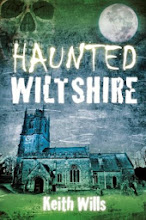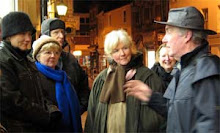
The Hanging Stone, Honey Street (SU099604)
The ‘Hanging Stone’ at Honey Street stands alone in the middle of a field close to the parish boundary. It’s a bit of an enigma really, but then one could argue that all ‘placed’ sarsens fall into that category.
There is a tale or two regarding its provenance. The first, if it be true, is an example of stupidity on an epic scale. The story goes, that at some time during the 18th century, a man was chased by several angry farmhands because he had absconded with a sheep which he had slung over his shoulder. Having put some distance from his pursuers, he looked for somewhere where he might catch his breath. He spied a large boulder and took refuge behind it. To ensure the sheep did not escape, he tied one end of a piece of rope (which he happened to be carrying) to the animal whilst securing the other end about his neck - oops! As he settled down behind the stone the sheep suddenly took fright and scampered up and over the stone snapping the rope taught and strangling the man where he sat.
The second tale is a gruesome reminder of man‘s barbarism. It is thought the stone may have marked the spot where a gibbet once stood, and the point where parish boundaries meet and where several tracks would have crossed, hence the common term hereabouts of ‘boundary stone.‘ In fact the parish boundary is but a few yards from the stone, a stone which appears to have been placed, such is its solitary position in the landscape. It is possible that medieval council would have held court here where boundaries met and tracks crossed. The accused - gagged and bound, would be tried and if convicted hung on the spot. The corpse would be left on the gibbet as carrion for birds and a stark warning to others. The boundary stone, once it had acquired an association with the courts would have been renamed hangman’s stone or hanging stone. It is said that that if you put your ear to the stone you may be able to hear the whispers of those who have met their end here. Not wishing to pass up an opportunity I put my ear to stone but all I heard on this occasion was the wind as it sang through the branches of nearby trees.
Wiltshire has many such sites where gibbets once stood, often on hillsides as is the case at Morgan’s Hill and Cherhill Down near Calne. But in nearly all cases gibbets were erected where boundaries met and roads crossed, for it was thought that should the spirit of condemned return, it would be so confused by all the routes that it would give up trying to find its way back.
There is no archaeological evidence to suggest the Hanging Stone played a part in any Neolithic henge, monument or alignment and so must remain like many of its contemporaries, a mystery.
How to get there
Head south through Honey Street, turn right into Hurst’s Lane which is not marked. Follow the lane till you reach a corrugated steel barn. Ahead of you is a dirt track, walk this track for about half a mile till you reach a right hand turn, the Hanging Stone is in a field to your right with the White Horse hill figure as its backdrop. Please note, although there is public access, you will still be on farmland so please follow the Country Code, thank you.






No comments:
Post a Comment